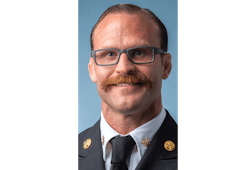Communication with our team members is a must. They want to talk with us, they want to see us, and when they do, they want us to be honest and willing to discuss topics that they consider to be important. As you progress in an organization, it’s key to keep the communication lines open, so everyone knows that you’re accessible as their leader. How this manifests can look substantially different in organizations that are larger in size. In organizations that are smaller in size, it’s much easier for the top-level leaders to reach out for the communication that’s needed to help to ensure a close-knit team.
The organization where I have spent my entire 19-year career has grown to 419 members from 246. To me, this still is a manageable number to be able to communicate with team members on a personal basis. Of course, there will be long periods of time in between you seeing everyone, but knowing them by first name and genuinely caring for them make this a very fun part of being a leader.
I started as a firefighter, scrubbing toilets and making coffee, so I didn’t believe that what I had to say mattered. As I progressed through the ranks, I looked for ways to improve my communication with members, and now as an assistant chief, I continue to do that. Three simple yet effective methods (other than phone calls) ensure that you remain close to those who you came up with and now are charged with leading.
Station visits
Our command staff has a tracking sheet for all assistant chiefs, deputy chiefs and the fire chief for the purpose of recording all of the station visits that we make per year.
We have a total of 17 stations and three shifts, with 24 apparatus and 96 people on shift each day. Our goal is to visit every station on every shift for 1–3 hours at least once per year. There is no agenda. We sit down at the kitchen table with the crew, drink coffee and talk shop. I find these visits so invigorating and such a joy to participate in. After all, the reason why I’m in a leadership position is because of the 419 people who I serve. If I don’t sit with them and have conversations, how do I know what they’re experiencing?
The same goes for me, too. They ask me all kinds of questions about my position and what challenges I see. I open up to them, because they must see that I have feelings and that things bother me, too.
I once was in their shoes, because I was blessed to go through every operational position before my current position as assistant chief. I know what they feel and their perspective. It used to be me.
On the last Tuesday of every month, my department’s assistant chiefs go to a station with 3–5 companies who meet there to discuss hot topics. This allows the leader of each division to answer any questions that the companies might have.
These visits have been so rewarding and educational for the members but also for the assistant chiefs. Even cooler, our fire chief is a huge proponent of station visits and lives what his expectations are. He goes on Saturday and/or Sunday mornings for 1–3 hours to drink coffee and talk shop. Members have time with the Big Boss of the organization. This is invaluable for the members and the command staff.
Text messages
In my experience, most people enjoy texting. It’s quick and effective and allows some team members to say things that they might not be able to bring themself to say in person.
I’m a huge fan of text threads. This is such an easy way to check in with people, so they know that you’re thinking about them. Do it when you don’t need anything. Only texting the people you work with when they can do something for you isn’t a good look. Text them just to say, “Hello,” or to show that you’re thinking about them or about something funny.
I try to text our battalion chiefs on shift a few times per week and do something called “story time.” I’ll text a story from a time that we worked together, and it’s so cool to see the engagement and laughter from that. I try to do it at times of the day that I know that it’s quiet for them. This used to be my most difficult time when I was a shift commander, because I was in my office by myself working on items for the shift. I would think about what other members in my department were doing. So, now, between 6 p.m. and 9 p.m., I send a text to the four operational battalion chiefs to let them know that I’m thinking about them, because I am. I miss being out there with them.
However, I know in my position that I can help them so much if I make the effort to keep in contact. I’m not the operations assistant chief. I’m the paperwork assistant chief, but I still want them to know that I’m in the bullpen if they need to call me in for the ninth inning.
FaceTime, Teams, Zoom
The ability to chat live on our phone and computer while we look at each other definitely is huge. Although I enjoy seeing our members face-to-face, if that isn’t physically possible, FaceTime, Teams and Zoom are just one click away.
When I was a shift commander, three other battalion chiefs and I who were on shift would FaceTime throughout the shift. It allowed us to have impromptu meetings, just check on each other and, of course, give each other some lighthearted grief about something.
Today, I FaceTime mostly just to check in on people and to see how they’re doing. Give this a try even if you aren’t a fan of it. As a leader, you must find ways to reach your people. This might be one of them, and you never will know if you don’t give it a try.
Major component of the goal
If you take away one piece of advice from this column, let it be this: Communicate with the members who you lead. Communication is essential for the health of the organization and for the morale of the organization’s members.
If this isn’t something that you currently do well, it’s OK. We all are trying to learn ways to be better and to help our organization to improve.
Our goal as a leader is to leave the organization better then we found it and also for those who take our position, to be better than we ever could be. A lot of this starts with communication.

Dr. David Griffin
Dr. David Griffin is the assistant chief of administration in Charleston, SC. He was the operator of the first-due engine on June 18, 2007, when nine of his fellow firefighters perished. Griffin has come through the ranks in operations in every uniformed position, from firefighter to battalion chief and shift commander to his current position, during his 19-year career in Charleston. He has a bachelor's degree in education from The Citadel, a master's degree in executive fire service leadership, and a doctorate of education in organizational leadership and development. Griffin is the author of "In Honor of The Charleston 9: A Study of Change Following Tragedy," among three other books. He is an international speaker and instructor, a certified Chief Fire Officer and Chief Training Officer with The Center for Public Safety Excellence, an IFSAC/Pro Board-certified Fire Officer IV and a graduate of the Executive Fire Officer Program from the National Fire Academy. He is a graduate of Harvard University's Kennedy School of Executive Education program: Senior Executives in State and Local Government and of the Psychology of Leadership program at Cornell University's SC Johnson College of Business. Griffin is the owner of On A Mission, LLC, at drdavidgriffin.com.






